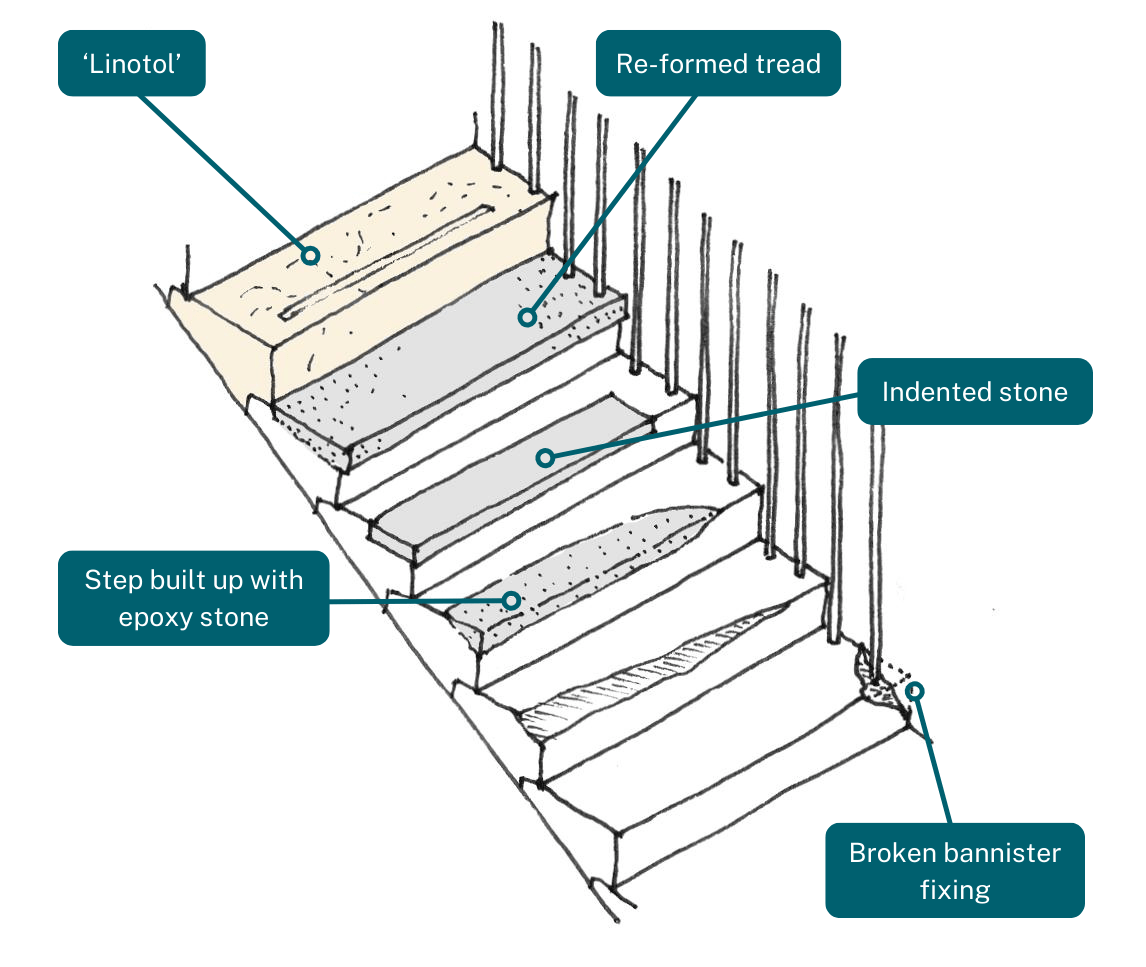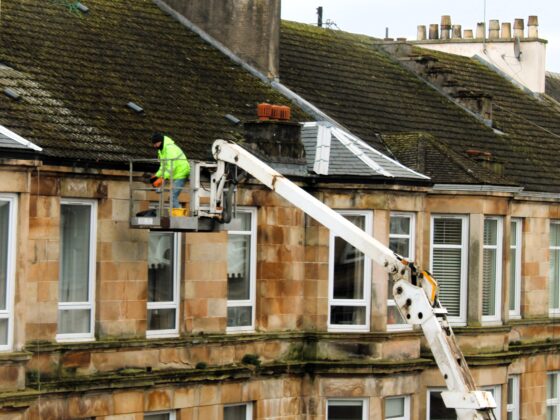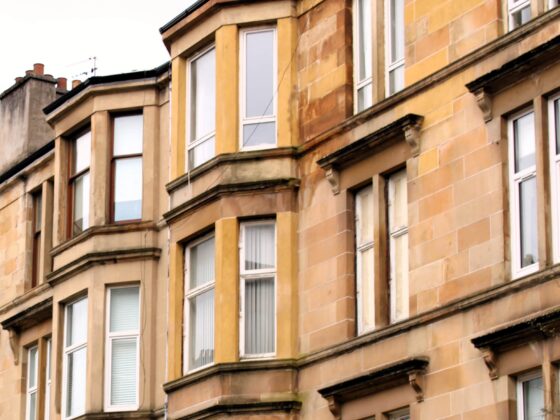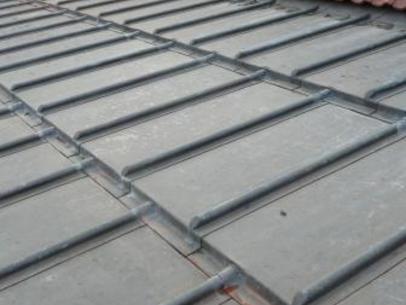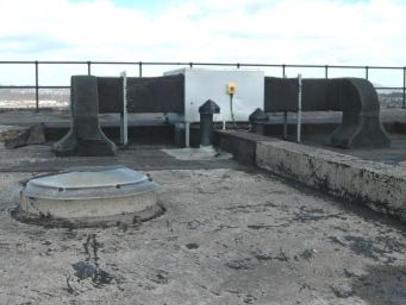The staircase and surrounding walls form an important part of your building’s structure.
How stairs are built
Stone stairs may be ‘penchecked’, with each step made from a separate piece of stone, which is specially cut to interlock with the treads above and below. These stairs may be:
- ‘open’ – with a banister or balustrade on one side, cantilevered out from the wall, perhaps supported by a beam or steel ‘T’ bar
- built around a spine wall with stairs supported on both sides
More modern buildings may have concrete stairs, either built as one piece or with separate treads supported by walls on both sides. Steel stairs with concrete treads can also be found.
 An open pencheck stair. Each step is interlocked with neighbouring steps.
An open pencheck stair. Each step is interlocked with neighbouring steps.
 Open pencheck stair. Note steel beam supporting open edge. In older Victorian tenements, this steel has been added later to strengthen the stair treads.
Open pencheck stair. Note steel beam supporting open edge. In older Victorian tenements, this steel has been added later to strengthen the stair treads.
 Stair built around spine wall. Note beam under landing by bottom step.
Stair built around spine wall. Note beam under landing by bottom step.
Landings in traditional stone tenements were usually formed with large stone slabs laid onto a timber support structure. The timber beams were replaced with steel beams, although stone slabs were still used to form the landings. Concrete landings became more common around 1900. Sometimes a landing may appear to be concrete, but it has just been resurfaced with a screed of mortar, the stone slabs may still exist under the screed.
Balusters made of iron are set into pockets in the stairs, the holes filled with molten lead to keep the baluster firm. At the top of each baluster is a rivet which fixes the baluster to a metal strap, to which the wooden banister is fitted. The banister rail helps strengthen the stairs. Loose or broken balusters are not only a risk as children can fall through, but can also weaken the stairs. Check if it is the baluster that is broken or the step that is damaged.
 Welcoming well-maintained balusters. Balusters and handrails are part of the structure of the stair.
Welcoming well-maintained balusters. Balusters and handrails are part of the structure of the stair.
Problems
- sloping steps – a sign of subsidence – may be caused by the close wall having poor foundations or the foundations being washed away by a leaking pipe or drain under the close (take structural engineer advice)
- gaps between pencheck stairs (inside building) – movement of one penchecked stair can leave the whole flight unsupported, could be dangerous as the stone treads should lock together (take structural engineer advice)
- stair tread cracks – a single tread may be cracked by a heavy or sudden load
- gaps in external stairs – weathering can wash away mortar or rust metal supports
- separation cracks may occur where the close/ stair wall joins the external walls
- rot outbreaks – landings built on timber joists may suffer from rot caused by water from excessive stair washing (an infrequent problem!)
In modern buildings, hairline cracks that open up in landings are most likely caused by a lack of adequate reinforcement or a failure in the curing process of the concrete. It may still be perfectly safe to walk on, but should be checked by a structural engineer just in case.
Solutions
Worn treads
Solutions in order of cost:
- steps built up using epoxy resin with a crushed stone mix
- new stone indent fitted – care needs to be taken not to cut too deeply into the stone or the indent will be too shallow
- full tread reformed with granolithic concrete mix – raises the height of the steps, so it needs to be applied to all landings and steps
- stairs and landings fully resurfaced with decorative composition floor, such as Linotol, with brass nosing strips and inset non slip strips
 ‘Linotol’ stair covering. Other products are available.
‘Linotol’ stair covering. Other products are available.
 ‘Linotol’ covered stairs. Lost nosings to treads means the ‘Linotol’ is easily damaged.
‘Linotol’ covered stairs. Lost nosings to treads means the ‘Linotol’ is easily damaged.
Stair tread cracks
An issue to be taken seriously with open pencheck stairs where each step rests on the other. Likely to be less serious where the outer edge of the stair is supported by a steel beam. Fix single cracked treads with stainless steel staples or replace the tread (a difficult job). If more treads are cracked, then stairs may need strengthening or rebuilding. Take structural engineer advice.
If the cracks are simply in the surface of a cement repair to the tread, then it is simply the cement that has failed, not the stone tread.
Missing balusters
Missing balusters should be replaced – you may find matching ones at architectural salvage yards or you can get new ones made.
 Missing balusters. A child could easily fall through this gap
Missing balusters. A child could easily fall through this gap
Loose stair rails
Loose stair rails can be tightened with additional screws through the strap. If the steel strap is broken, then it can be welded.
Professional help recommended?
Although the work may appear straightforward, ensure your builder or tradespeople have the skills for the job. If in any doubt, get professional help to specify and organise the repair. Get professional help quickly if you detect any cracks on the stairs.
Who pays?
These are normally common or mutual repairs. There may be particular issues with main door flats and shops.
Further information

